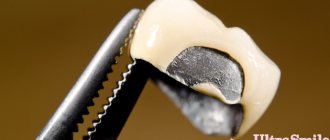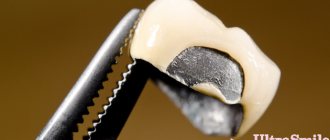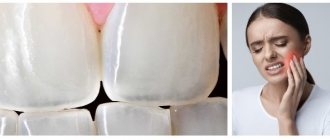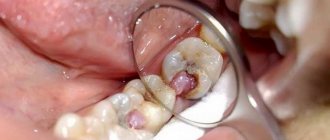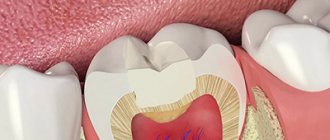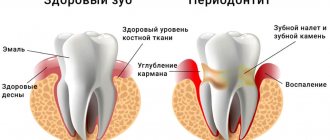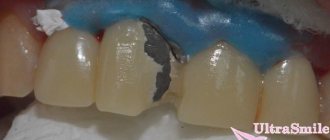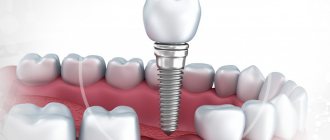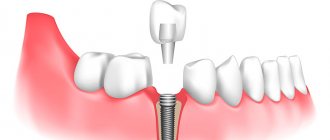A crown is a permanent prosthetic structure that is used to replace the visible part of a missing or damaged tooth. The service life of the product depends on various factors. First of all, this is the quality of the design, accuracy of installation, material and localization in the oral cavity. With proper care and respect, dentures can last more than 10 years. Replacement of the structure is required if there is bad breath, discomfort, looseness or damage. In this case, the patient is recommended to consult a dentist.
Is it possible to remove the crown?
Almost every patient who has undergone orthopedic treatment wonders whether it is possible to remove the crown from a tooth. Installing a crown is a non-removable type of prosthetics, but this does not mean that they cannot be removed in principle. In dentistry, removable dentures are those structures that can be pulled out of the mouth independently. In turn, fixed dentures are removed in the dentist's office using special equipment and tools. Another popular question: which doctor removes crowns from teeth? This should be done by an orthopedic dentist, but in some clinics the therapist also removes crowns, which, of course, is not entirely correct.
All
Fixed prosthetics
- Crowns
- Metal-ceramic crowns
- Metal-free crowns
- All-ceramic crowns
- Crowns based on zirconium oxide
- Temporary crowns
- Microprosthetics (tabs)
- Veneers
- Hollywood veneers (Lumineers)
Removable prosthetics
- Complete removable dentures
- Partially removable dentures
- Partially removable dentures made of plastic
- Clasp dentures
Why is crown removal necessary?
The average lifespan of a standard crown that covers a natural tooth is about seven years. If the crown is installed on an implant, then it may well last for fifteen years. As a rule, the removal of a crown from a tooth is carried out for a number of reasons.
- Errors during prosthetics. Most often, the fault lies with specialists who made a mistake at one of the stages of treatment. Incorrect manufacturing of the product, incorrect calculations at the preparatory stage, the use of low-quality materials - all this leads to the fact that the prosthesis cannot function properly and has to be removed.
- Injuries and mechanical damage, after which further use of the dental crown becomes impossible.
- Diseases developing under the crown. Secondary caries, periodontitis, cysts are complications in which tooth treatment without removing the crown is almost impossible.
- Gum diseases requiring removal of the denture for treatment procedures.
- Expiration date. Each crown has its own lifespan (especially when installed on a natural tooth). If a crown has lost its functional and aesthetic qualities over time, it must be replaced. Often the crown falls out on its own due to damage or destruction of the bonding agent.
- The desire of the patient himself. For example, in order to replace an old metal or metal-ceramic structure with a more modern and aesthetic product.
Dangerous symptoms!
- Constant pain under the crown indicates the development of an inflammatory process and the need for re-treatment.
- Unpleasant odor concentrated in the crown area. It usually occurs due to the decomposition of tissue under the crown or the ingress of food particles, which indicates a violation of the seal.
- The crown becomes mobile. This is due to decay of the tooth or dental cement under the crown.
If you experience the above symptoms in one form or another, we advise you to contact your dentist as soon as possible. After taking an x-ray, it will become clear whether you have a hidden problem and whether the crown needs to be removed.
Reviews
Dental prosthetics is not the cheapest service provided by dental clinics. Therefore, before the procedure, it would be useful to approach the search for an experienced doctor with special care.
This will help avoid unforeseen situations when, due to mistakes made during installation, re-prosthetics cannot be avoided.
If after reading the article you would like to share your own opinion on this topic, leave your comment below.
If you find an error, please select a piece of text and press Ctrl+Enter.
Tags: dental crowns, fixed dentures, removal of a crown from a tooth
Did you like the article? stay tuned
Previous article
The essence of using individual zirconium abutments
Next article
The use of an angular abutment to achieve high aesthetic prosthetics
How are crowns removed from teeth?
There are several ways to remove dental crowns.
Sawing
An old and rather crude way. After this, it is no longer possible to remove the crown and put it back. The technique is considered cheap and quite effective, but the final success largely depends on the experience of the doctor - a tooth or gum may be damaged in the process.
Removal using a Kopp apparatus
The Kopp apparatus is a special tool that resembles both a refueling nozzle and a hook (due to the hook-shaped nozzle). The doctor grinds off the cement at the base of the crown, then picks it up with a tool and presses the release. This is a fairly quick and effective method with the only drawback - during the extraction process, chips of the prosthesis may occur.
Ultrasonic crown removal
Involves destruction of cement using ultrasound. The method is well suited for removing old crowns. However, if the material is too dense and strong (for example, glass ionomer cement), ultrasound may not be able to cope with it.
Removal using the Coronaflex device
The operation of the Coronaflex device, which looks like a pistol from the future, is based on the principle of compressed air. The air flow is supplied under high pressure, destroys the cement, but at the same time has a gentle effect on the crown and adjacent tissues. Removing a prosthesis using a device will cost significantly more than other methods. However, if you have a zirconium crown costing 25,000 rubles, it makes sense to overpay a little.
Method No. 4: Kop (Koch) apparatus
This is a tool that again has a hook at the end. However, the device is not launched mechanically, but using a button, which breaks the cement along the edge of the crown using small shocks or a shock wave, after which the structure begins to move from its place. Next, the doctor can only use special forceps that hook and help to finally remove the prosthesis.
See what the Koch apparatus for removing crowns looks like in the photo.
This is what the Koch apparatus for removing crowns looks like
This device is more convenient and efficient than a manual device; it allows you to remove the product with virtually no damage and “works” quickly. However, it also has disadvantages. In particular, many patients note that during the procedures they feel “twitching” and discomfort. Also, some people are very concerned about the noise that the device makes. There is one more drawback - the device can damage the ceramic coating of the crown, leaving chips and cracks, and then the structure will have to be restored.
Does it hurt to remove a crown?
No, especially if the procedure is performed under anesthesia. Removing a crown from a tooth is painful if there is a living tooth underneath it that is undergoing an inflammatory process, but in the vast majority of cases, crowns are placed on pulpless teeth. In such a situation, the procedure may cause some discomfort, but you most likely will not experience severe pain. If your teeth hurt after removing crowns, there are two options. Either mechanical damage has been caused to the gum, or pulpitis, periodontitis or granuloma develops in the tooth. In this case, complex endodontic treatment is required.
Rehabilitation period
If necessary, the doctor will prescribe medications and painkillers. It is equally important to follow a number of rules for the first 3-4 days that will prevent the development of complications:
- Do not rinse your mouth.
- Do not chew or brush your teeth on the extraction side.
- Do not take a hot bath or visit a bathhouse or sauna.
- Do not engage in sports or heavy physical labor.
- Avoid air travel (especially if the operation was on the upper jaw).
2-3 days after removal you should come for a follow-up examination, and after 5 days the sutures are removed.
To the list of posts
Treatment of a tooth under a crown without removing it
In dental practice, there are cases when it is possible to cure a tooth without removing the crown. Usually we are talking about secondary caries and simple endodontic manipulations, carried out through a hole, which is then filled with a composite material. In some cases of surgery, such as cyst removal, the surgical site is accessed through an incision in the gum. In this case, the product usually still has to be removed for additional manipulations.
What are the advantages of gold?
The precious metal is popular with many people who need prosthetics. The choice in favor of gold is explained by a number of positive characteristics:
- the chemical element does not cause allergies;
- does not corrode in the aggressive environment of the oral cavity;
- is not rejected by tissues;
- does not react with food and liquids used for nutrition and hygiene purposes;
- has high strength;
- does not affect the condition of neighboring teeth and does not cause changes in enamel color;
- can be used to form any type of teeth;
- the plasticity of the material makes it possible to repeat the anatomical shape of the future prosthesis;
- compatibility with other materials used in orthodontics;
- has a long service life;
- maintains healthy microflora in the oral cavity;
- Microparticles, when ingested, provide an anti-inflammatory effect.
Crowns differ not only in the type of tooth, but also in terms of area coverage.
Kinds
Full
Complete – covers the tooth surface completely. Can be made using stamping from preliminary blanks. This method is rarely used. The one-piece manufacturing method is more often used. The monolith repeats the anatomy of its tooth. The technology is imperfect due to the need for preparation.
Half crown
Half-crown - a partial crown is a non-removable structure that covers the tooth on four surfaces: oral, lateral and incisal. The buccal or labial surface remains free. This type of crown is placed on premolars and front teeth. Another name is three-quarter, although in fact the product covers 4/5 of the tooth surface.
The structure can be used as a supporting element of a prosthesis (bridge, brugel) or as part of a splint.
Equatorial
Equatorial – covers the crown part of the tooth. This type is used when erasing enamel, as a support for splinting and as an element of bridge prostheses.
Stump
A stump crown is a deep structure for restoring a completely or partially destroyed tooth.
With metal-ceramic coating
Gold crown with metal-ceramic coating. The method is based on the production of a frame made of gold, which is covered with ceramic mass. This is done primarily for aesthetic purposes.
Pin
A crown on a pin is installed in case of complete loss of a tooth. The base, frame or entire prosthesis can be made of gold with or without a metal-ceramic coating.
